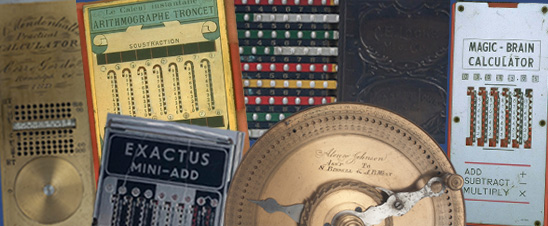The instrument consists of three concentric brass discs, a brass marker, a steel stop, and a wooden handle (instrument must be removed from box to find handle). Each brass disc has the numbers from 0 to 99 stamped around the edge.
- Description
-
The instrument consists of three concentric brass discs, a brass marker, a steel stop, and a wooden handle (instrument must be removed from box to find handle). Each brass disc has the numbers from 0 to 99 stamped around the edge. The two inner discs both have a circle of 100 holes just outside the numbers. The inner holes are used to add the last two digits of a number by rotation. Any hundreds value in the sum carries to the second set of holes, which are used to add hundreds and thousands places.
-
The machine is in a cylindrical wooden case with cover.
-
According to the Kirksville [Missouri] Democrat for August 2, 1888, by then Hart had sold 3500 of these devices and “he lately ordered one thousand more.”
-
References: U.S. Patent #199289
-
P. Kidwell, "Adders Made and Used in the United States," Rittenhouse, 1994, 8:78-96.
-
Kirksville [Missouri] Democrat, August 2, 1888.
- Location
-
Currently not on view
- date made
-
1878
- patentee
-
Hart, William
- maker
-
Scovill Manufacturing Company
- ID Number
-
1993.0510.01
- accession number
-
1993.0510
- catalog number
-
1993.0510.01
